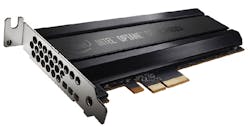Download the PDF of this article.
Intel’s Optane memory technology is finally available and it has possibilities when it comes to embedded platforms. In terms of performance, Optane sits between DRAM and flash memory. It has the non-volatility of flash memory but faster performance. The challenge for developers is that Optane’s price and capacity are higher and lower, respectively, compared to flash memory.
The 80-mm M.2 version is available in 16- and 32-Gbyte versions (Fig. 1). It targets consumer PCs as a cache for hard drives. The capacity is much lower than flash memory, which currently tops out at 2 Tbytes. Intel uses only two lanes of a possible four-lane NVMe interface.
1. Intel’s Optane M.2 is available in 16- and 32-Gbyte versions.
The specs for the M.2 module are impressive. It has a read latency of 9 µs while write latency is 30 µs. Sequential read and write throughput is 1,350 Mbytes/s and 290 Mbytes/s, respectively. Random read and write performance is 240,000 and 65,000 IOPS. Active power requirements are 3.5 W while it idles at 1 W. Another place where Optane shines is write endurance. The lifetime write endurance rating is 182.5 Tbytes. That’s more than 5,800 drive writes.
M.2 sockets are becoming more common on embedded motherboards. They’re actually the norm with new consumer and enterprise motherboards. M.2 sockets can also be found in PCI Express boards.
“Embedded designs, thanks to their custom application software, are probably more ready to use persistent memory than are more standard applications,” said Jim Handy, analyst at Objective Analysis, “and a lot of the pieces are already in place, since SNIA and the Linux community have hammered out programming standards to support it. But even if these designs don’t take advantage of Optane’s persistence, it’s still a good fit for a lot of applications since it’s faster than flash and cheaper than DRAM. This gives it the capability to reduce overall system costs while boosting performance, which is a ‘Win-Win’ for nearly any computing configuration.”
Embedded developers tend to have an advantage over consumer configurations as the performance requirements of an application are often known. This makes selection of memory technology, capacity, and performance easier. High capacity is not always a requirement for many embedded applications. This means that there will be some applications where Optane’s specs work better than flash memory. The application may work with Optane as the primary storage medium or as a cache.
Intel is targeting the enterprise with the PCI Express P4800X (Fig. 2). The larger form factor has a capacity of 375 Gbytes. It uses a x4 PCI Express interface. The P4800X has an endurance of 30 drive writes/day with a total endurance of 12.3 Petabytes.
2. The Optane P4800X PCI Express board targets the enterprise.
Some embedded applications may be able to take advantage of this form factor with the same considerations afforded to the M.2 module. It probably won’t be applicable for rugged applications given its specifications that are more amenable for enterprise server farms.
This is only the initial availability of Optane. Embedded designers tend not to jump on the bandwagon, but instead will wait to see how the technology develops.
About the Author
William G. Wong
Senior Content Director - Electronic Design and Microwaves & RF
I am Editor of Electronic Design focusing on embedded, software, and systems. As Senior Content Director, I also manage Microwaves & RF and I work with a great team of editors to provide engineers, programmers, developers and technical managers with interesting and useful articles and videos on a regular basis. Check out our free newsletters to see the latest content.
You can send press releases for new products for possible coverage on the website. I am also interested in receiving contributed articles for publishing on our website. Use our template and send to me along with a signed release form.
Check out my blog, AltEmbedded on Electronic Design, as well as his latest articles on this site that are listed below.
You can visit my social media via these links:
- AltEmbedded on Electronic Design
- Bill Wong on Facebook
- @AltEmbedded on Twitter
- Bill Wong on LinkedIn
I earned a Bachelor of Electrical Engineering at the Georgia Institute of Technology and a Masters in Computer Science from Rutgers University. I still do a bit of programming using everything from C and C++ to Rust and Ada/SPARK. I do a bit of PHP programming for Drupal websites. I have posted a few Drupal modules.
I still get a hand on software and electronic hardware. Some of this can be found on our Kit Close-Up video series. You can also see me on many of our TechXchange Talk videos. I am interested in a range of projects from robotics to artificial intelligence.




